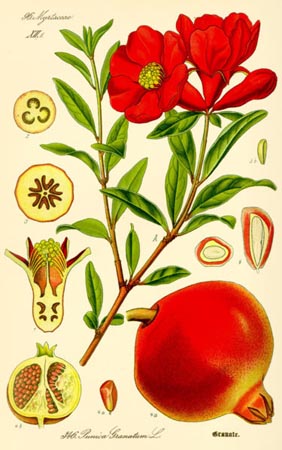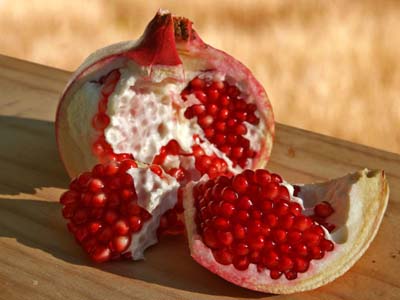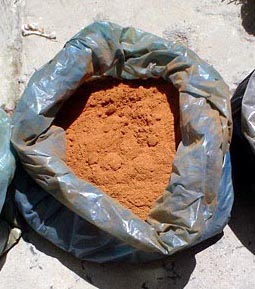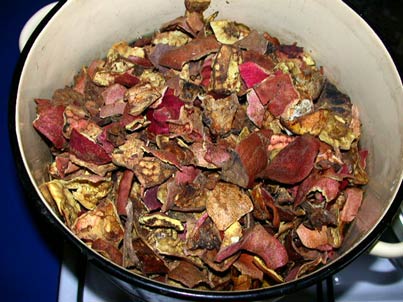|
The Pomegranate (Punica granatum) is a fruit-bearing deciduous shrub or small
tree growing to 5–8 m tall. The pomegranate is native from Azerbaijan to the
Himalayas in northern India and has been cultivated and naturalized over the
whole Mediterranean region and the Caucasus since ancient times. It is widely
cultivated throughout Azerbaijan, Iran, India, the drier parts of southeast
Asia, Malaya, the East Indies, and tropical Africa. Introduced into Latin
America and California by Spanish settlers in 1769, pomegranate is now
cultivated mainly in the drier parts of California and Arizona for its fruits
exploited commercially as juice products gaining in popularity since 2001.
The leaves are opposite or sub-opposite, glossy,
narrow oblong, entire, 3–7 cm long and 2 cm broad. The flowers are bright red, 3
cm in diameter, with four to five petals (often more on cultivated plants). The
fruit is between a lemon and a grapefruit in size, 5–12 cm in diameter with a
rounded hexagonal shape, and has thick reddish skin and around 600 seeds. The
seeds and surrounding pulp, ranging in colour from white to deep red, called
arils, are edible; indeed, the fruit of the pomegranate is a berry. There are
some cultivars which have been introduced that have a range of pulp colours such
as purple.
The only other species in the genus Punica, Socotra Pomegranate (Punica
protopunica), is endemic to the island of Socotra. It differs in having pink
(not red) flowers and smaller, less sweet fruit. Pomegranates are drought
tolerant, and can be grown in dry areas with either a Mediterranean winter
rainfall climate or in summer rainfall climates. In wetter areas, they are prone
to root decay from fungal diseases. They are tolerant of moderate frost, down to
about −10°C (14°F). |
 |
|
Etymology
The name "pomegranate" derives from Latin pomum ("apple") and granatus
("seeded"). This has influenced the common name for pomegranate in many
languages (e.g. German Granatapfel, seeded apple). The genus name Punica is
named for the Phoenicians, who were active in broadening its cultivation, partly
for religious reasons; consequently in classical Latin the fruit's name was
malum punicum or malum granatum, where "malum" was broadly applied to many
apple-like fruits. From the latter derived its Italian name melograno and the
less used form of that melagrana. A separate, widespread root for "pomegranate"
is the Egyptian and Semitic rmn. Attested in Ancient Egyptian, in Hebrew rimmôn,
and in Arabic rummân, this root was brought by Arabic to a number of languages,
including Portuguese (romã), and Kabyle rrumman and Maltese "rumen".
Pomegrante in history
The pomegranate originated from Caucasus and Iran. It has been cultivated in
Azerbaijan, Georgia and the whole Mediterranean region for several millennia.
Carbonized exocarp of the fruit has been identified in Early Bronze Age levels
of Jericho, as well as Late Bronze Age levels of Hala Sultan Tekke on Cyprus and
Tiryns. A large, dry pomegranate was found in the tomb of Djehuty, the butler of
Queen Hatshepsut; Mesopotamian cuneiform records mention pomegranates from the
mid-Third millennium BCE onwards. It is also extensively grown in South China
and in Southeast Asia, whether originally spread along the route of the Silk
Road or brought by sea traders.
The ancient city of Granada in Spain was renamed after the fruit during the
Moorish period. Spanish colonists later introduced the fruit to the Caribbean
and Latin America, but in the English colonies it was less at home: "Don't use
the pomegranate inhospitably, a stranger that has come so far to pay his
respects to thee" the English Quaker Peter Collinson wrote to the botanizing
John Bartram in Philadelphia, 1762. "Plant it against the side of thy house,
nail it close to the wall. In this manner it thrives wonderfully with us, and
flowers beautifully, and bears fruit this hot year. I have twenty-four on one
tree... Doctor Fothergill says, of all trees this is most salutiferous to
mankind." The pomegranate had been introduced as an exotic to England the
previous century, by John Tradescant the elder, but the disappointment that it
did not set fruit there led to its repeated introduction to the American
colonies, even New England. It succeeded in the South: Bartram received a barrel
of pomegranates and oranges from a correspondent in Charleston, South Carolina,
1764. Thomas Jefferson planted pomegranates at Monticello in 1771: he had them
from George Wythe of Williamsburg.
Symbolism of Pomegranate
-
Exodus 28:33–34 directed that images of pomegranates be woven
onto the borders of Hebrew priestly robes.1 Kings 7:13–22 describes
pomegranates depicted in the temple King Solomon built in Jerusalem. Jewish
tradition teaches that the pomegranate is a symbol for righteousness, because
it is said to have 613 seeds which corresponds with the 613 mitzvot or
commandments of the Torah. For this reason and others, many Jews eat
pomegranates on Rosh Hashanah. The pomegranate is one of the few images which
appear on ancient coins of Judea as a holy symbol, and today many Torah
scrolls are stored while not in use with a pair of decorative hollow silver
"pomegranates" (rimmonim) slid down over the two upper scroll handles.
-
For the same reason, pomegranates are a motif found in
Christian religious decoration. They are often woven into the fabric on
vestments and liturgical hangings or wrought in metalwork.
-
The wild pomegranate did not grow natively in the Aegean area
in Neolithic times. It originated in eastern Iran and Caucasus and came to the
Aegean world along the same cultural pathways that brought the goddess whom
the Anatolians worshipped as Cybele and the Mesopotamias as Ishtar.
-
The myth of Persephone, the dark goddess of the Underworld,
also prominently features the pomegranate. In one version of Greek mythology,
Persephone was kidnapped by Hades and taken off to live in the underworld as
his wife. Her mother, Demeter (goddess of the Harvest), went into mourning for
her lost daughter and thus all green things ceased to grow. Zeus, the highest
ranking of the Greek gods, could not leave the Earth to die, so he commanded
Hades to return Persephone. It was the rule of the Fates that anyone who
consumed food or drink in the Underworld was doomed to spend eternity there.
Persephone had no food, but Hades tricked her into eating four pomegranate
seeds while she was still his prisoner and so, because of this, she was
condemned to spend four months in the Underworld every year. During these four
months, when Persephone is sitting on the throne of the Underworld next to her
husband Hades, her mother Demeter mourns and no longer gives fertility to the
earth. This became an ancient Greek explanation for the seasons. It should be
noted that the number of seeds that Persephone ate is varied, depending on
which version of the story is told. The number of seeds she is said to have
eaten ranges from three to seven, which accounts for just one barren season if
it is just three or four seeds, or two barren seasons (half the year) if she
ate six or seven seeds. There is no set number.
-
The pomegranate also evoked the presence of the Aegean Triple
Goddess who evolved into the Olympian Hera, who is sometimes represented
offering the pomegranate, as in the Polykleitos' cult image of the Argive
Heraion (see below). According to Carl A. P. Ruck and Danny Staples, the
chambered pomegranate is also a surrogate for the poppy's narcotic capsule,
with its comparable shape and chambered interior. On a Mycenaean seal
illustrated in Joseph Campbell's Occidental Mythology 1964, figure 19, the
seated Goddess of the double-headed axe (the labrys) offers three poppy pods
in her right hand and supports her breast with her left. She embodies both
aspects of the dual goddess, life-giving and death-dealing at once. The Titan
Orion was represented as "marrying" Side, a name that in Boeotia means
"pomegranate", thus consecrating the primal hunter to the Goddess. Other Greek
dialects call the pomegranate rhoa; its possible connection with the name of
the earth goddess Rhea, inexplicable in Greek, proved suggestive for the
mythographer Karl Kerenyi, who suggested that the consonance might ultimately
derive from a deeper, pre-Indo-European language layer.
-
In the 6th century BCE, Polykleitos took ivory and gold to
sculpt the seated Argive Hera in her temple. She held a scepter in one hand
and offered a pomegranate, like a royal orb, in the other. "About the
pomegranate I must say nothing," whispered the traveller Pausanias in the
second century AD, "for its story is something of a mystery." Indeed, in the
Orion story we hear that Hera cast pomegranate-Side into dim Erebus — "for
daring to rival Hera's beauty", which forms the probable point of connection
with the older Osiris/Isis story. Since the ancient Egyptians identified the
Orion constellation in the sky as Sah the "soul of Osiris", the identification
of this section of the myth seems relatively complete. Hera wears, not a
wreath nor a tiara nor a diadem, but clearly the calyx of the pomegranate that
has become her serrated crown. In some artistic depictions, the pomegranate is
found in the hand of Mary, mother of Jesus.
-
In modern times the pomegranate still holds strong symbolic
meanings for the Greeks. On important days in the Greek Orthodox calendar,
such as the Presentation of the Virgin Mary and on Christmas Day, it is
traditional to have at the dinner table "polysporia", also known by their
ancient name "panspermia," in some regions of Greece. In ancient times they
were offered to Demeter[citation needed] and to the other gods for fertile
land, for the spirits of the dead and in honor of compassionate Dionysus. In
modern times the symbolic meaning is assumed by Jesus and his mother Mary.
Pomegranates are also prominent at Greek weddings and funerals. When Greeks
commemorate their dead, they make "kollyva" as offerings that consist of
boiled wheat, mixed with sugar and decorated with pomegranate. It is also
traditional in Greece to break a pomegranate on the ground at weddings, on New
Years and when one buys a new home for a house guest to bring as a first gift
a pomegranate which is placed under/near the ikonostasi, (home altar), of the
house, as it is a symbol of abundance, fertility and good luck. Pomegranate
decorations for the home are very common in Greece and sold in most homegoods
stores.
-
In the mythology and art of Azerbaijan, one
can often come across the description of pomegranate trees, especially in the
carpets woven in Karabagh, Shirvan and Tabriz. These descriptions were also
applied in Uyghur (Khotan) and Anatolian Turkish
carpets.
|

|









